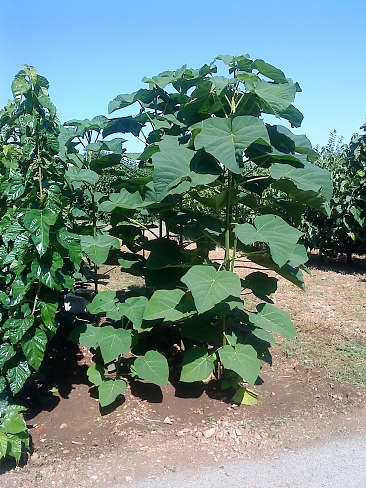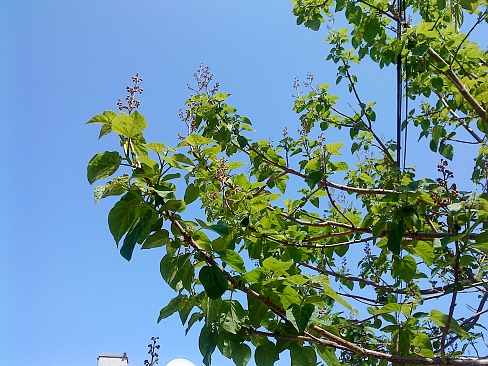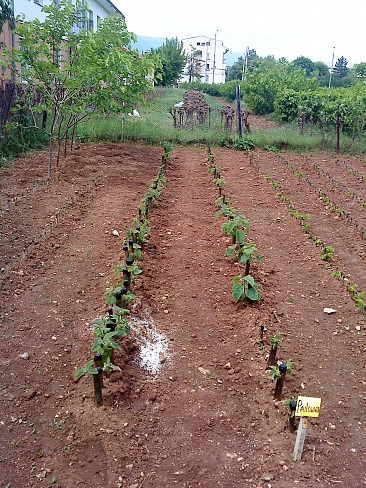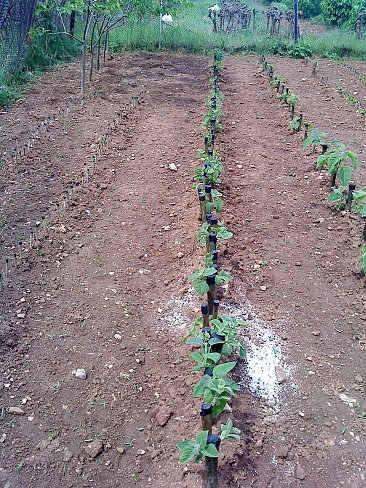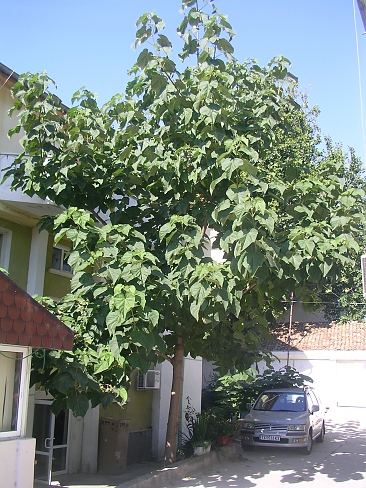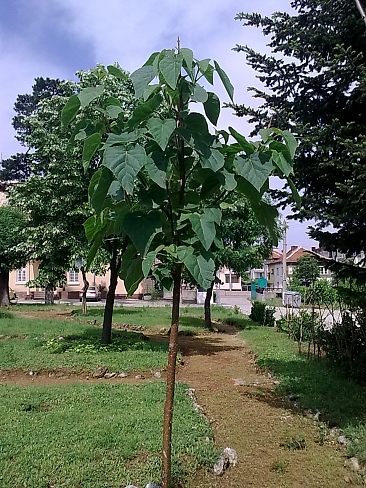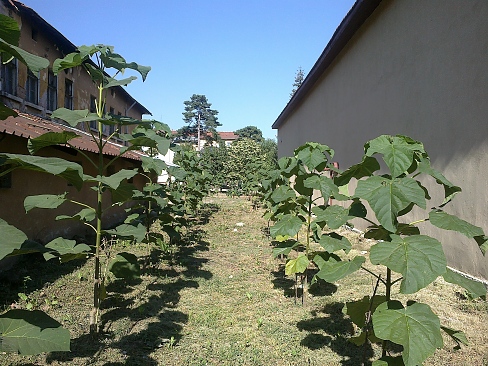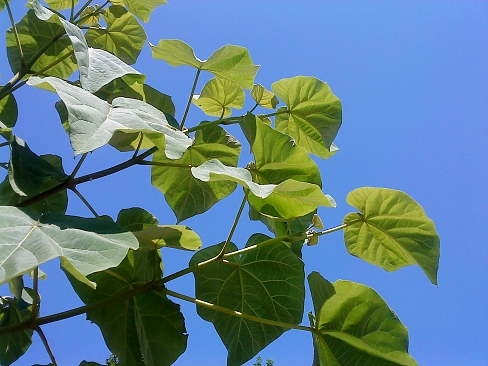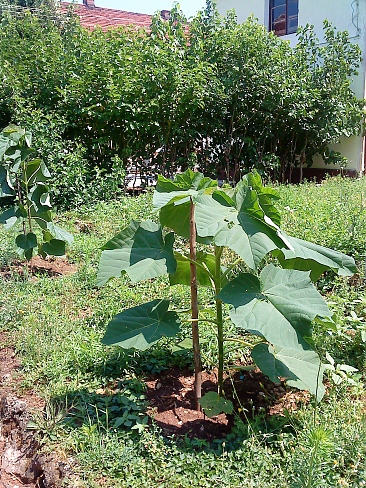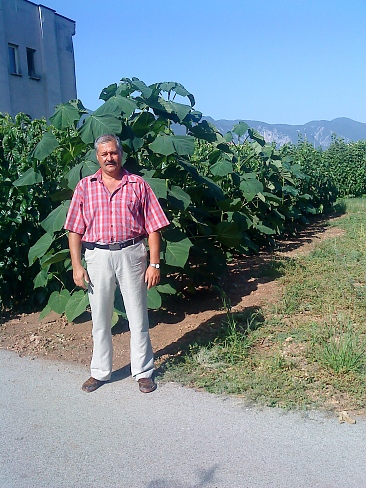Selling PAULOWNIA saplings
Sericulture and Agriculture Experiment Station, Vratsa, Bulgaria produces and sells high quality paulownia saplings of a specially selected hybrid which possess both high tolerance to cold in the winter and performs very vigorous growth rate. The paulownia hybrid is suitable both for wood and biomass profuction.
ABOUT PAULOWNIA:
HYSTORY AND WORLD DISTRIBUTION
The genus Paulownia is native to China and Paulownia has been cultivated for at least 2000 years.
The earliest known record about Paulownia is in a book called Erh-ya, thought to have been written in the third century BC by a disciple of Confucius.
In AD 1049 Ch'en Chu produced a treatise entitled T'ung-p'u. This shows that the Chinese people had a profound knowledge of Paulownia as a cultivated tree almost 1000 years ago. The history of the genus, methods for propagation and cultivation, habitat and origins of the best varieties, pruning and utilization, were all described in T'ung-p'u.
A significant publication from medieval times was Pen-ts'ao-kung-mu, written by Li Shih-chen. Li described Paulownia wood as light, resistant to insect attack, and useful for furniture, beams and pillars. He is the first to record the medicinal properties of the genus, giving eight prescriptions for the use of leaves, bark and flowers.
GENERAL DESCRIPTION OF PAULOWNIA
Habit: Deciduous trees up to 27 m tall. Crowns spreading, open, and rounded to pyramidal.
Bark: Light grey and smooth or slightly fissured on older trees; soft and easily damaged, especially on trees less than 7 years old.
Leaves: Opposite, simple, stalked and pubescent. Juvenile leaves ovate, up to 80 cm wide, margins usually coarsely serrate, petioles long. Adult leaves up to 32 cm wide, cordate, margins entire or occasionally three to five lobed.
Flowers: In terminal branched clusters up to 40 cm long. The calyx is five lobed. Individual flowers 5-11 cm long, petals united into a tube with the upper part divided into five unequal white lobes, throat often yellow with purple spots. There are four stamens.
Fruit: A woody capsule 3-10 cm long, beaked, two-valved.
Seed: Butterfly-shaped, 2-7 mm long, membranous-winged and grooved.
Leaves: The size and shape of Paulownia leaves vary considerably within a species and even on a single tree. Young plants, coppice growth and vigorous shoots have particularly large leaves. Mature leaves of some species may differ in the size, shape, shininess of the upper surface or in the shape of the minute hairs on the under-surface.
CLIMATE AND SITE
Paulownia is clearly site-sensitive and cannot tolerate heavy soils or frost-prone sites.
Temperature: Paulownia is known to tolerate a wide range of temperatures. In China the northern limit appears to be related to the January -5oC isotherm. In the south, trees grow where the summer maximum exceeds 40oC. When dormant the trees can withstand temperatures till -20oC (P. Тomentosa).
Rainfall: Paulownia, in China, grows where annual rainfall is as low as 500 mm during the growing season. It also grows in regions of high rainfall up to 3000 mm. The main requirement is for water to be plentiful during the period of maximum growth.
Paulownia can only be expected to grow well in areas where summer rainfall is adequate, or where the land can be irrigated. If soil becomes saturated with water for a few days, the trees may to survive.
Light: Paulownia is a light-demanding genus. Some works has shown that the light saturation point is 60 000 lux, a very high value compared to that for most other tree species (20 000 - 30 000 lux, 20-30%.
Wind: Paulownia seeds are dispersed by wind and have been known to travel for distances up to 1 km from the parent tree. Strong winds can break young plants and saplings, but do not seem to cause much damage to older trees.
Wind damage is more pronounced and wind patterns must be considered during site selection. Breakage of young stems and branches can occur when wind speed exceeds >40 km/hour. Wind affects crown shape in Paulownia and may inhibit height growth after the third or fourth year. Any plantation should be sited so that the speed of wind blowing through is no greater than 28 km/hour.
Soil: Paulownia will grow on a wide range of soils, but the best development occurs in those that are deep and well drained. A clay component greater than 25% and porosity of less than 50% are not suitable. Paulownia will not grow well where drainage is poor and trees will die if soil which is relatively dry in summer becomes water-logged.
Paulownia does not tolerate soil salinity in excess of 1%. Paulownia will grow in nutritionally infertile soils if texture and drainage are satisfactory. There is some evidence that application of nitrogen fertiliser will increase the growth rate of young plants.
ESTABLISHMENT OF PLАNTATIONS
The optimum time for planting out nursery-grown Paulownia in Bulgaria is late autumn/early spring.
Grassed sites: Grassy areas should be spot-sprayed at least 3 weeks before planting. Spots should be at least 1.5 m in diameter. The herbicide should be capable of knock-down and long-term weed control for at least 9 months.
Spacing: Recommended spacing is 7 x 7 m for plantations (204 stems/ha) and 5 m for single row shelter belts. Wider spacing results in faster initial growth, which may reduce the value of the timber. Closer spacing will reduce growth rates over the first 3-4 years. Alternatively, trees can be planted at 7 x 3.5 m spacing (408 stems/ha) and thinned out later.
Planting: Рlanting holes should be as large as possible - in heavier soils at least 30 x 30 x 30 cm. For planting single trees, the hole should be half-filled with friable soil (mixed with fertiliser, if required) and the plant placed so that the junction between root and stem will be about 1 cm below the final soil level. Remaining soil is then replaced and firmed with the foot.
Irrigation: Watering will be required if rainfall during the first growing season is less than 100 mm per month. As a rough guide, 10 mm of rainfall supplies about 100 litres of water. Irrigation will also be required in subsequent years if monthly rainfall falls below 50 mm. Inadequate water supply only slows growth, but does not cause mortality.
Post-planting weed control: Weed control promotes maximum growth and tree health. A circle 1.5 m in diameter around each tree should be kept free of weeds for at least 2 years. Spraying should be carried out in spring just before growth recommences, but care should be taken to see that the spray does not contact the tree stem.
TREE FORMING
The aim is to produce a crop of trees with good form and healthy growth. This is done by careful removal of malformations by removing branches that are not essential for the maintenance of optimum levels of photosynthetic activity.
The sprouting of new shoots from the trunk is a reaction to stress. It is a mechanism for increasing the leaf area of the tree and may occur at any stage. Unwanted shoots should be removed, and the source of stress should be determined and alleviated wherever practicable.
Elongation pruning (form pruning): Elongation pruning is carried out to encourage development of a trunk at least 6 m long before crown formation is allowed. On good sites this can be achieved in 2 years; elsewhere 3or 4 years will be needed.
The first operation is carried out in the spring when the new shoots are about 2 cm long. The strongest pair (second to fourth from the top) is selected and a diagonal cut is made across the tree and the top are removed. The trees should be examined every 2 to 3 weeks during the following 2 months so that any vigorous lower branches can be remuved. If the selected leader fails, the pruning process can be repeated.
The elongation pruning procedure is repeated in the second and, if necessary, the third year after planting.Any lateral branches with butt diameters greater than 3 cm should be cut back to half length. This will reduce diameter growth and make the spring pruning much easier.
Lateral pruning: Pruning of lateral branches reduces the size of knots which can spoil the quality of timber in the trunk. If new branches do sprout they should be rubbed off by hand as soon as possible.
- The first operation is carried out 2.5 years after planting, providing that the trees are more than 4 m tall. All branches are removed from the bottom third of the main stem, and any other branches with butt diameters greater than 3 cm cut back to one-third length.
- The second pruning operation is carried out 12 months later on trees that are more than 6 m tall. Lateral branches below half tree height are removed and higher branches with butt diameters greater than 3 cm are cut back to one-third length.
- The final pruning takes place when the trees are 4.5 years old. They are pruned leaving a pruned trunk length of 6 m. Pruning of individuals that are less than 8 m in height should be deferred for another year.
Coppicing: Trees with poor initial growth can be rejuvenated by coppicing. Paulownia, like many other deciduous species, reacts to removal of the trunk by forming new and very vigorous shoots. This occurs at any point of removal whether at ground level or higher.
Trees should not be coppiced for at least 2 years after planting. This ensures that the root system is well-developed. At the end of the second or third winter, just before growth is due to start, the stems of poorly-shaped trees are cut off at ground level. Several shoots will develop and all but the most vigorous one should be removed. Regrowth is fast and the shoot will be straight unless it is affected by wind. Height growth during the subsequent season should be equal to that in uncoppiced trees.
Pollarding: Rejuvenation of trees with poor initial growth can also be achieved by pollarding. This operation is carried out on trees which have a straight trunk 2-5 m long. The crown is removed at a point that will leave the maximum trunk length. When new shoots develop, the topmost one is selected as the new leader. All of the lower branch sprouts are removed.
GROWTH AND YIELD
Little is known about the growth rate and timber productivity of plantation-grown Paulownia. Plantation in China has expected to yield about 100 m3/ha when harvested at age 10 years. Chinese sawmills indicated an average log size of 0.6 - 0.7 m3 at age 7 - 10 years.
Paulownia growth in Japan appears to be relatively slow when compared with growth rates in China. Mean annual increment at stocking rates of 380 - 750 stems/ha is about 18 m3.
In Australia double-row Paulownia shelterbelt containing 200 stems/km would yield 300 m3/km at age 20.
In the USA the expected average yield from 40-year-old Paulownia plantations is 250 - 275 m3/ha. Expected mean tree volume is about 2 m3.
In Brazil growth is rapid and increments of 11 - 30 m3/ha/annum, depending on site, have been obtained.
OTHER USES FOR PAULOWNIA
Other than traditional forestry uses for timber, Paulownia can provide many other useful products, which makes it attractive for growing, as single trees, in shelterbelts, or in plantations.
Honey: Paulownia is reputed to be a good nectar producer but there is little published information.
Medicinal: Paulownia has long been used in traditional Chinese medicine but there seems to have been little modern analysis of the potential of the genus in this area. The leaves contain ursolic acid, matteucinol; the xylem paulownin, d-sesamin; the bark syringin and catalpinoside. As well the fruits contain acid, fatty oils, flavanone, and alkaloid.
Fodder: Analysis of the feed value of Paulownia reveals that the above-ground parts contain high levels of useful nutrients. In China pigs and poultry have been fed, experimentally, with Paulownia leaves. Providing not more than 15% (dry weight) of Paulownia leaves is added to the pig feed, there is no significant weight loss.
With poultry it has also been demonstrated that a feed mix containing 19% dried Paulownia leaves will increase egg production by 3.3% and egg weight by 1.7%.
TIMBER UTILISATION
Paulownia timber is widely used in Asia. It is light, odourless, and easily worked. In color it varies from silver-grey (highly prized in Japan) to light brown. It has a low density but is easy to dry and, although unsuitable for structural use, has physical and mechanical properties that are acceptable for other purposes. Paulownia wood has been used for a wide variety of purposes in China and Japan for more than 1500 years.
The main products are:
- Housing components requiring lower timber strength.
- Aircraft fittings requiring light wood.
- Furniture, especially drawers. This is because the wood fits snugly and is insect-resistant.
- Musical instruments.
- Barrels, especially those used for acids, wine, etc.
- Beehives, for which light-weight and good insulating properties are needed.
- Aqueducts, in rural areas.
- Handcrafts, because the wood is easy to carve.
- Rice bowls and other utensils.
- Wooden boxes for gifts or storage of paintings and scrolls.
- Charcoal for fireworks and filters.
- Wood pulp – which is white and strong.
- Wood shavings for packaging and insulation.
- Packaging, especially light crates.
